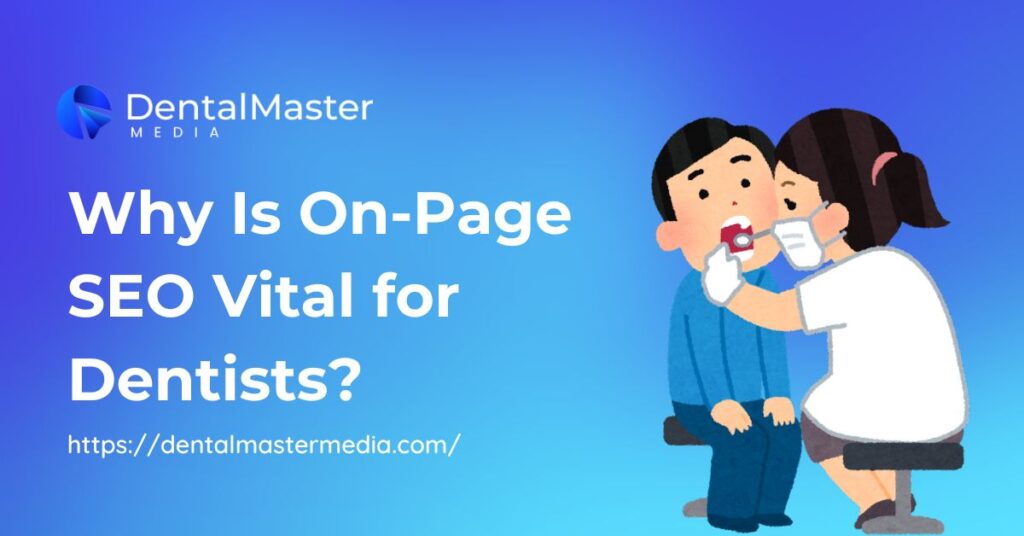Most people who find your practice online decide in a few seconds whether to stay or leave. They skim your title, glance at a heading, and look for a phone number or a clear “Book Now” prompt.
On-page SEO shapes those moments so they are simple, fast, and helpful. It guides search engines and real people at the same time.
Done well, it turns quick scans into calls and bookings. This is where SEO For Dentists makes a direct impact by aligning each page with what patients are trying to find right now.
What Is On-Page SEO for Dental Websites?
On-page SEO covers the parts of a page you control,titles, meta descriptions, headings, copy, images, internal links, and structured data.
It helps search engines understand your topic and helps visitors take the next step. Off-page work still matters, but the visit begins and ends on your pages, so clarity here affects every result down the line.
A trusted SEO Company For Dentists can optimise these elements effectively, making sure your website is clear, search-friendly, and ready to turn visitors into patients.
A simple definition and how it differs from off-page work
Off-page signals,like links from other sites,act as reputation. On-page signals are about clarity and service.
They explain the topic, show quality, and make actions easy. You need both, but visitors feel on-page choices first, because those choices are what they see and use.
Why it matters for patients and search engines
Search engines reward pages that answer questions quickly and keep people engaged. Patients reward those same pages by staying longer and booking.
When content is easy to read, headings make sense, and forms are short, the page sends positive signals that support future visibility.
Titles, Meta Descriptions, and URLs: Your First Impression
Titles and meta descriptions are your show window in search results. They should match patient language and promise a clear benefit. Good titles set expectations; good descriptions explain why your result is the right next click.
Writing clear, helpful titles that match patient intent
Write titles that reflect the main need behind a search. “Emergency Dentist for Tooth Pain,Same-Day Care” is stronger than a vague clinic name.
Keep titles within sensible length so they display well. Start with the core topic, then add one helpful detail a worried patient cares about.
Meta descriptions that earn clicks
Use one or two short sentences that speak to relief, convenience, or next steps. Mention helpful points like transparent pricing information or flexible hours.
Avoid repeats from the title; add detail that gives a reason to click your result over another.
Clean, readable URLs
Short, descriptive URLs are easier to understand. “/dental-implants” is clear, while “/page?id=1234” is not.
Keep case and separators consistent, use hyphens between words, and avoid filler terms that add length without meaning.
Headers and Page Structure That Patients Can Scan
Many visitors skim before they decide to read. Clear headings guide those eyes through the page and signal what each section covers.
Using H1/H2/H3 to guide readers
Use one H1 that states the main topic of the page. Break the content into H2 and H3 sections that mirror patient questions.
When headings follow a logical path, visitors can jump to the part they care about and stay engaged.
Matching each section to a patient question
Plan sections around common questions like what the treatment is, who it suits, what recovery feels like, and how to book.
Answer each question with a short, direct paragraph. End sections with a natural next step, such as reading a guide or booking.
Content That Answers Real Patient Questions
Content earns trust when it explains the problem, the solution, and the next step in simple language. Avoid jargon unless you explain it right away.
Service pages with purpose (pain → treatment → next step)
Start with the symptom or concern a patient feels. Explain the treatment step by step and address comfort and safety.
Close with a practical prompt, such as calling, booking online, or messaging your team for advice.
FAQs that reduce calls and boost trust
Turn common front-desk questions into short Q&A entries. Keep answers tight and plain. Link to deeper guides or related services so those who want more detail can find it without searching again.
Adding helpful media without slowing the page
Photos and short videos help nervous patients feel at ease. A reception tour or a one-minute “what to expect” clip can calm fears.
Compress media, use modern formats, and include transcripts so nothing blocks fast loading.
Trust Signals and E-E-A-T, Explained Simply
Trust online comes from clear authorship, real experience, and proof. When your content reflects this, patients feel safe and search engines pick up the right signals.
Clear author info, credentials, and policies
Include short bios with degrees, focus areas, and professional memberships. Add a friendly photo and a line on your care approach.
State appointment, cancellation, and emergency policies in plain terms so people know what to expect.
Reviews and proof without fluff
Place two or three short patient quotes on pages where doubt is high, such as implants, root canal, braces, or emergency care.
Keep quotes specific and believable. A steady flow of fresh comments across your site and profiles reinforces trust.
Local Signals on the Page
Most dental searches have local intent. On-page choices can confirm that you are nearby and available.
Adding Dental SEO Services for Dentists makes your site more relevant, helping patients find you when they search locally.

NAP consistency and contact details
Show your name, address, and phone in a consistent format. Place contact info in the header or footer and on the contact page. Add opening hours and an easy way to call or message.
Location pages and what to include
Create a page for each area you serve. Describe how to reach you, parking or transport tips, and the services people there ask about most. Link from each location to the relevant treatments and to your booking flow.
Structured Data for Dentists (Schema Markup)
Structured data helps machines read your page accurately. It can also enable rich results that attract attention.
LocalBusiness/Dentist basics
Use LocalBusiness or Dentist schema to mark up your practice name, address, phone, and hours.
Keep the data in step with what the page shows. Small errors can ripple across listings, so accuracy matters.
FAQ, HowTo, and Video schema
If you include a short FAQ, mark it up so search engines recognize the questions and answers.
For step-by-step care guides, consider HowTo. For explainer clips, use VideoObject. These additions give clearer signals and can improve result appearance.
Images, Media, and Accessibility
Images should support understanding, not slow the visit. Accessibility helps all users and can improve engagement.
Alt text, file names, and compression
Give files descriptive names and write alt text that says what the image shows or why it is there.
Compress images so they load quickly on mobile data. Replace heavy slideshows with a few clear photos if speed is an issue.
Easy-to-tap buttons and readable text
Make buttons large enough for thumbs and keep forms short. Use a readable font size and strong color contrast. Place key actions near the top and again near the end so people do not have to hunt for them.
Site Speed and Mobile Experience
Speed shapes first impressions. Mobile experience shapes whether a visit becomes a booking.
Why seconds matter
Delays lead to drop-offs, especially for visitors in pain. A fast page keeps people reading, reduces bounces, and raises the chance they will call or book. Speed improvements often pay off quickly.
Simple fixes that help
Compress images, lazy-load media below the fold, and remove scripts you do not need. Limit heavy fonts and plugins. Test your most important pages and fix the biggest slowdowns first.
Internal Linking That Guides Patients
Internal links guide readers to the right next step and help search engines understand your structure.
Hubs, spokes, and booking paths
Create hub pages for major service groups and link to detailed treatments. From each treatment page, link to booking, prices, and a related guide or FAQ.
From blog posts, add links to the matching service so readers can act without another search.
Anchor text that is clear and natural
Write anchors that match what the click delivers, such as “emergency dentist appointments” or “clear aligner costs.” Avoid vague phrases and keep wording natural so the page reads smoothly.
Measuring What Works
Track on-page SEO that moves patients to act. Focus on clicks, calls, forms, and rankings. See which pages drive results and fix weak ones with clearer openings, better headings, and stronger CTAs. Dental Master Media suggests reviewing one high-value page weekly for steady gains.
A Simple 30-Day Improvement Plan
Week 1: Refine titles and meta descriptions.
Week 2: Improve the first 150–200 words.
Week 3: Compress media and polish mobile layout.
Week 4: Add or expand FAQs from real patient questions.
Review results and repeat with an SEO For Dentists checklist.
Common On-Page Mistakes to Avoid
Avoid keyword stuffing, duplicate location pages, and thin content. Strengthen weak pages with details, photos, and a clear path to book,or merge them with stronger ones.
Titles, Metas, and Content Examples (Patient-Focused)
Write with search intent in mind. A parent typing “braces for teens” should see “Braces for Teens,Clear Options and Simple Care,” with clear details on types, comfort, and timelines.
Add a short video of the first visit and simple payment info. For “emergency dentist near me,” use “Emergency Dentist”.
Same-Day Help for Tooth Pain,” then explain when to call, what to do at home, and how fast you can help. These small steps meet urgent needs and drive appointments.
Local Pages That Pull Their Weight
Strong local pages answer where you are, how to reach you, and what services locals ask about most.
Link directly to those services, and repeat contact info at the top and bottom for quick calls or bookings.
Accessibility and Plain Language Help Everyone
Accessibility builds trust. Use clear contrast, label fields, keep sentences short, and explain jargon in plain terms. For example, describe “root canal treatment” as therapy for the inside of the tooth.
Short, Actionable 30-Day Plan
Tackle one key page each week.
Week 1: sharpen title and meta.
Week 2: improve the opening.
Week 3: add strong links and compress images.
Week 4: refine buttons and review results.
Then repeat with the next high-value page.
Why On-Page SEO Lifts Both Rankings and Bookings
Clear intent-matched titles, guiding headings, and helpful content keep people engaged. Strong engagement signals boost visibility, while better user experience leads to more bookings.
Bringing It All Together
On-page SEO turns quick scans into real actions. Titles and metas earn clicks, headings guide reading, content answers concerns, and fast media plus clear links make booking easy. Small steps add up to steady growth.
Conclusion
On-page SEO matters because clear, fast pages serve real people in real moments. It helps someone in pain find help quickly, gives parents the details they need for a child’s visit, and makes every next step simple.
Start with one key page this week and improve the parts a visitor feels first,the title, the opening lines, the mobile buttons, and the path to book.
If you want a practical plan that fits your clinic’s goals, the team at Dental Master Media can guide you through the next steps.

Suraj Rana is the owner of Dental Master Media and a leading expert in SEO for dental practices. With a passion for dental marketing, he has successfully helped numerous dental clinics climb the search engine ranks. Suraj’s expertise makes him a go-to resource for effective, results-driven dental marketing.

